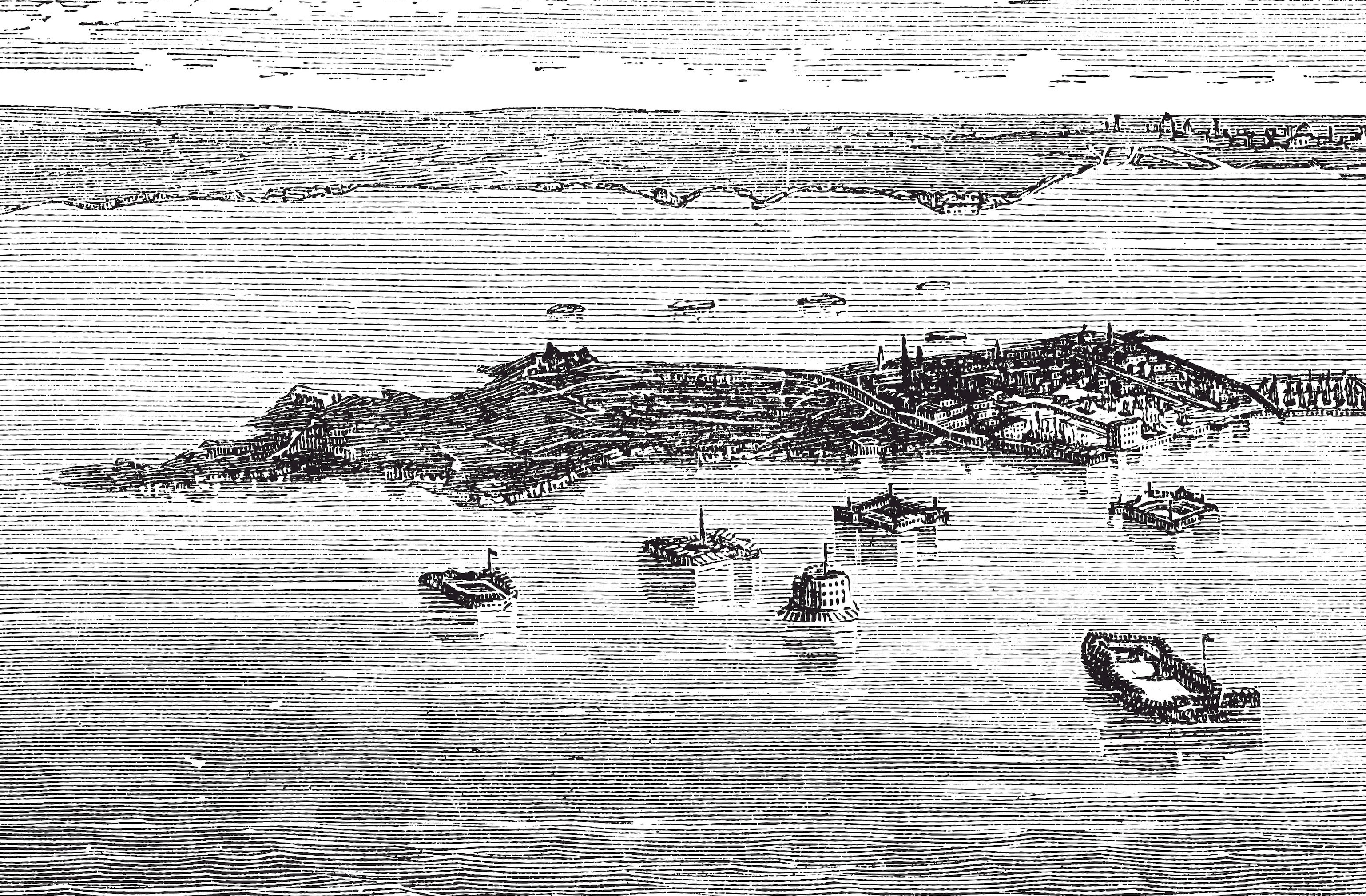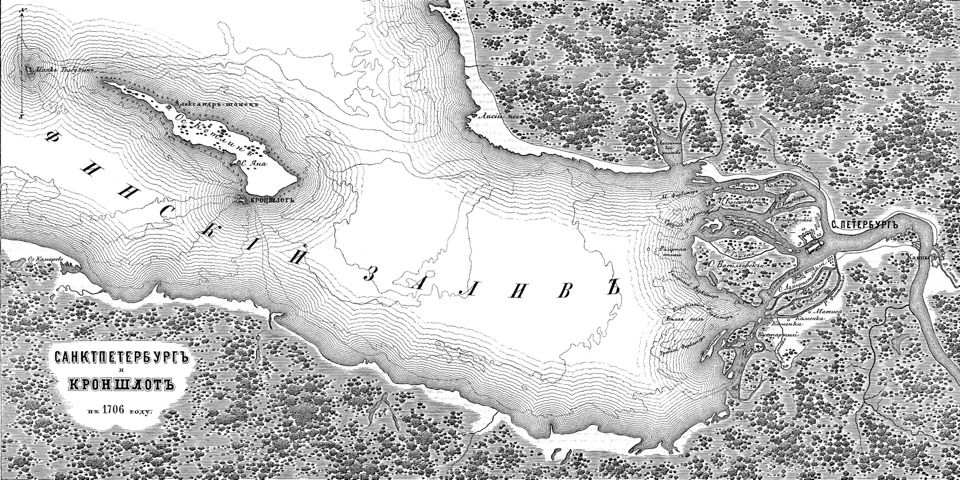The history of Kronshtadt began at the end of 1703 with the construction of a wooden fortress on the shoals to the south of the island of Kotlin. The three-tiered tower, personally designed by Peter the Great and called Kronslot, was erected in just a couple of months. Next year, the fortress successfully repulsed the attack of the Swedish squadron…
Продолжая работу с данным сайтом, вы подтверждаете и соглашаетесь на использование сайтом cookies и сервиса аналитики.
History of Kronshtadt
1703
1713
Foreign trade ships began to arrive in Kronshtadt in 1713, when the first port harbors were built on the island. This year began the “correct foreign trade”. Within a few years, from 150 to 180 foreign ships called at the port of Kronshtadt.

1719
In 1719, during a heavy storm, the 54-gun ship “London” ran aground. After this incident they began to light a fire in the lamps at the Kotlin Spit for the safe passage of ships at night. Two years later, the construction of a wooden lighthouse started at the site of the crash of “London”.

1720
On May 23, port customs was established in Kronshtadt. The personal decree of Peter the Great commanded: “Those sailors skippers, who will have goods on the merchant ships coming to the port of Kronshtadt and St. Petersburg, will give receipts of those goods to the customs and, after inspection and rewriting, they can sell them from the ships to whom they want, and with that sale they shall pay a duty on the goods according to the trade regulations, only for the import, and shall not pay any other duty for sale.”

1723
At two o’clock in the afternoon of October 6, 1723, the fortress on the island of Kotlin received its official name. Peter the Great baptized his beloved child, and after a solemn prayer service, cannon shots announced to Europe that the new fortress was called Kronshtadt.
1786
The Kronshtadt established the Maritime Assembly, or the Nautical Club, which became famous, including its collection of books. By the beginning of the 20th century, its library contained more than 100,000 volumes of various contents and ranked first in Russia in terms of the wealth of books in some departments.
…the boat could not compete in speed, and was far behind the steamer…
1815
The beginning of steamship communication. On November 3, 1815, the first steamer in Russia was launched in St. Petersburg. To escort to the Kronshtadt raid, a 12-rowboat was attached to the steamer for security purposes. However, the boat “could not compete in speed, and was far behind the steamer.”

1824
On June 20, 1824, an external steamship communication was opened. The first foreign steamer to come to Kronshtadt was the Swedish “Stockholm”. The steamer had only 52 tons of displacement and arrived with passengers and goods. The steamship communication with London and Revel was opened, the steamers sailed under the English and Dutch flags.
For more than 300 years, Kronshtadt experienced several dozen floods. The largest happened on the night of November 8, 1824, when water reached 11.5 feet above the ordinary line, and the city itself was flooded with water to Bocharnaya Street. Of the 94 vessels in the harbor, only 12 survived afloat.

1839
Admiral Faddey Faddeevich Bellingsgausen, a famous Russian navigator, one of the discoverers of Antarctica, was appointed Chief Commander and Military Governor of Kronshtadt. Bellingsgausen led Kronshtadt until his death in 1852. There is a monument to the admiral in the Catherine Square of the city.

1847
By the middle of the XIX century, it became clear that the sails as an engine on military ships should give way to steam engines. In 1847, the construction of the Steamboat plant began on the northeast coast of Srednyaya Harbor.
1861
The Kronshtadt Gazette started to be published in Kronshtadt. This was a private publication, which was subsidized by the Maritime Ministry. In 1896, another newspaper named “Kotlin” started to be published.
1879
In place of the wooden Vladimir Church, first built in 1735 and then burned to the ground during the fire of 1874, a new stone church was built — the Vladimir Cathedral of the War Department.
In the 50s of the 20th century, the church was tried to blow up three times. Today the building has been restored and is an active temple.
1921
In March, after the elections to local councils, where the Bolshevik deputies did not pass, an armed uprising began in Kronshtadt, one of whose demands was: “Power to the Soviets, not parties!”. The uprising was only suppressed at the second attempt. The Kronshtadt mutiny became one of the most significant episodes of the Civil War.

1936
At the studio “Mosfilm” came out the feature film “We are from Kronshtadt”.


1941
On September 23, 1941 Kronshtadt was raided by German Luftwaffe. The period of the siege began, which lasted until June 1944. Food was delivered to the city along the Little Road of Life, which connected Kronshtadt with Oranienbaum and Fox Nose.
1996
From Soviet times to the mid-1990s, Kronshtadt was a closed city, entry without special permission was banned for both foreigners and Russians. Since 1996, the city is partially open to the public.

2009
Kronstadt was awarded the title of “City of Military Glory.” In 2013, the image of the city was placed on the reverse of a 10-ruble coin.
2019
The construction of the military-historical park “Kronshtadt” starts on the island.
Forts of Kronshtadt
История Кронштадта
